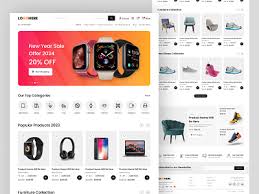
The Importance of Ecommerce Design for Online Businesses
When it comes to running a successful online business, having an effective ecommerce design is crucial. Your website’s design plays a significant role in attracting customers, encouraging them to make purchases, and building trust in your brand.
Here are some key reasons why ecommerce design is essential for the success of your online business:
- User Experience: A well-designed ecommerce website provides a seamless and intuitive user experience. Easy navigation, clear product images, and a simple checkout process can help increase conversions and keep customers coming back.
- Brand Identity: Your website’s design is often the first impression customers have of your brand. A visually appealing and cohesive design can help establish your brand identity and make your business stand out from competitors.
- Mobile Responsiveness: With more people shopping on mobile devices, having a responsive design that looks great on all screen sizes is essential. A mobile-friendly ecommerce site can improve user experience and boost sales.
- Trustworthiness: A professional-looking website instills trust in potential customers. Clear product descriptions, secure payment options, and a polished design can help build credibility and encourage shoppers to make purchases.
In conclusion, investing in a well-designed ecommerce website is crucial for the success of your online business. By focusing on user experience, brand identity, mobile responsiveness, and trustworthiness, you can create a website that attracts customers, drives sales, and helps your business grow.
7 Essential Tips for Effective Ecommerce Website Design
- Ensure a clean and user-friendly interface for easy navigation.
- Optimize for mobile devices to cater to mobile shoppers.
- Use high-quality images and videos to showcase products effectively.
- Implement a streamlined checkout process to reduce cart abandonment.
- Include customer reviews and ratings to build trust with potential buyers.
- Incorporate clear call-to-action buttons for guiding visitors towards making a purchase.
- Utilize analytics tools to track user behavior and make data-driven design decisions.
Ensure a clean and user-friendly interface for easy navigation.
To enhance the user experience and encourage seamless browsing on your ecommerce website, it is essential to ensure a clean and user-friendly interface for easy navigation. A clutter-free design with intuitive navigation menus, clear product categories, and prominent search functionality can help visitors find what they are looking for quickly and efficiently. By simplifying the browsing process, you can improve customer satisfaction, increase engagement, and ultimately boost conversions on your online store.
Optimize for mobile devices to cater to mobile shoppers.
To enhance the user experience and maximize sales potential, it is essential to optimize your ecommerce design for mobile devices. With a growing number of consumers shopping on their smartphones and tablets, ensuring that your website is responsive and user-friendly on mobile platforms is crucial. By catering to the needs of mobile shoppers with a mobile-optimized design, you can improve accessibility, engagement, and ultimately drive conversions for your online business.
Use high-quality images and videos to showcase products effectively.
Using high-quality images and videos is a crucial tip for effective ecommerce design. Visual content plays a significant role in capturing the attention of online shoppers and showcasing products in the best light possible. Clear, detailed images and engaging videos can help customers better understand the features and benefits of the products, leading to increased interest and higher conversion rates. By investing in top-notch visual content, businesses can create a more immersive and engaging online shopping experience that encourages customers to make confident purchasing decisions.
Implement a streamlined checkout process to reduce cart abandonment.
Implementing a streamlined checkout process is a crucial tip in ecommerce design to reduce cart abandonment. By simplifying the steps required for customers to complete their purchase, you can minimize friction and increase the likelihood of conversions. A user-friendly checkout process with clear instructions, minimal form fields, and multiple payment options can help create a seamless shopping experience that encourages customers to follow through with their purchase, ultimately boosting sales and improving overall customer satisfaction.
Include customer reviews and ratings to build trust with potential buyers.
Including customer reviews and ratings on your ecommerce website is a powerful strategy to build trust with potential buyers. When shoppers see positive feedback from other customers, it helps them feel more confident in their purchasing decisions. By showcasing real experiences and opinions, you can demonstrate the credibility of your products or services and create a sense of transparency that fosters trust and loyalty among your audience.
Incorporate clear call-to-action buttons for guiding visitors towards making a purchase.
Incorporating clear call-to-action buttons is a crucial tip for effective ecommerce design. These buttons serve as signposts that guide visitors towards making a purchase, ultimately driving conversions and increasing sales. By strategically placing prominent and visually appealing call-to-action buttons throughout your website, you can create a seamless user experience that encourages visitors to take the desired action. Clear and compelling CTAs help streamline the buying process, reduce friction, and enhance overall usability, leading to a more successful online shopping experience for customers.
Utilize analytics tools to track user behavior and make data-driven design decisions.
To enhance the effectiveness of your ecommerce design, it is essential to leverage analytics tools to monitor user behavior and derive valuable insights. By tracking metrics such as page views, click-through rates, and conversion rates, you can gain a deeper understanding of how visitors interact with your website. This data-driven approach empowers you to make informed design decisions that are based on real user data, ultimately leading to a more optimized and user-friendly ecommerce experience.
